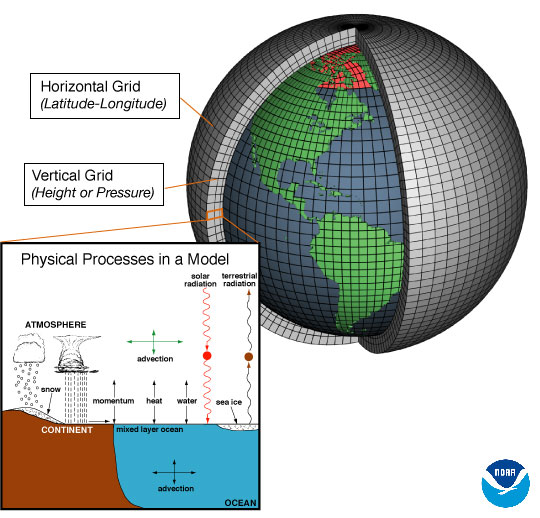A major source of uncertainty in future climate projections is the effect of clouds. This is because clouds generally occur on scales smaller than the resolution of a climate model. A climate model breaks up, or discretizes, the earth into a collection of grid cells. In the simplest case, a point at the center of each grid cell defines the properties of temperature, moisture, and wind for the entire grid cell. Due to limited computer power, climate models are usually run with grid cells about 50 miles wide. Clearly, clouds typically occur on scales much smaller than 50 miles. Because of this, they go ‘unresolved’ by the climate model and their aggregate effects would otherwise be missing. However, even though clouds are relatively small compared to the grid cell they play critical roles in transferring heat and moisture and interacting with the sun-earth radiative balance. Therefore, it is necessary to represent they effects they have.
Representing the effects of the unresolved processes of a model is traditionally referred to as ‘parameterization’ in meteorology. Since most clouds go unresolved, we must parameterize their effects. There are many ways to parameterize clouds and turbulence. Traditionally, different parameterization schemes have been developed for different cloud and turbulence regimes. For example, one parameterization may only aim to represent the shallow cumulus clouds while another represents only the ‘deep-convective’ clouds (thunderstorms). An increasing focus of research has been on how to unify these different parameterizations into one single parameterization which is a more theoretically sound approach.
At UWM, our research group is developing a unified parameterization of clouds and turbulence. It is called the Cloud Layers Unified by Binormals (CLUBB). When implemented in a climate model, CLUBB assumes the sub-grid variability of temperature, moisture, and wind inside of a grid cell takes the form of a statistical distribution. From there we can predict the cloudiness inside the grid cell and relay that information to the climate model. A key advantage of CLUBB is that it is wholly consistent. For example, the fraction of the grid cell that CLUBB predicts to be cloudy is consistent with the amount of turbulence or the temperature profile. Another key advantage is that it is unified and aims to represent all clouds. Therefore, CLUBB is well poised to simulate processes that traverse cloud regimes rather quickly. For example, the transition from shallow to deep convection spans dry convective boundary layers, shallow clouds, growing cumulus, and then deep convective clouds producing copious amounts of precipitation. Over land, this transition can be abrupt and is difficult to parameterize.
My research aims to improve CLUBB’s representation of this transition. In order to do so, I use a high resolution cloud resolving model and carefully compare the statistics between the high resolution model and CLUBB.

2. MODIS imagery over Amazonia with 1 degree latitude/longitude overlays. Each square is the typical size of a grid cell in a climate model. Notice all of the variability of cloudiness inside each grid cell. Without parameterization, the effect of those clouds would be missing in the climate model.

3. Simulated cloud field
Simulated cloud field over the size of a typical grid cell in a climate model. We use the statistics derived from this model to help guide improvements to CLUBB.
